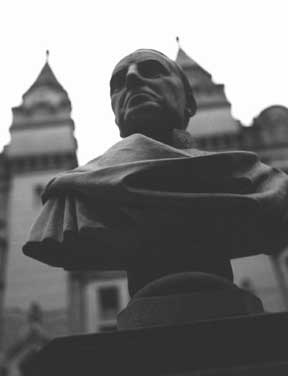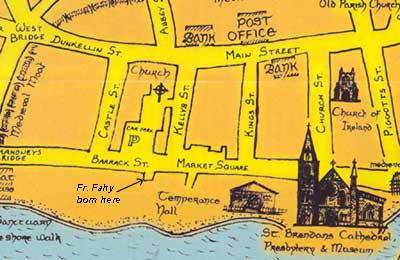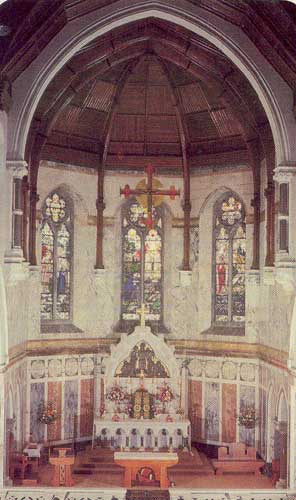
|
Anthony Fahy of Loughrea by Michael Fahy*
|
|
|
|
The Irish community in Argentina glows in the memory of its first Chaplain, Fr. Anthony Fahy O.P. (1805-1871). Fr. Fahy was born in Loughrea, Co. Galway, where his family were proprietors of an extensive brewery on Barrack Street. He was ordained at St. Clement’s College in Rome in 1831. Having finished his theological studies, he left for the Dominican mission in Ohio, U.S.A, whence through broken health he was obliged to return to Ireland where he was appointed Prior of Black Abbey Convent in Kilkenny. In 1844 he was appointed by the Archbishop of Dublin to the Chaplaincy of the Irish in Argentina. He arrived there on his thirty-ninth birthday, 11 January 1844, aboard the British Packet. From January 1844 until his death during the Yellow Fever epidemic of 1871, in Buenos Aires, Fr. Fahy ministered in the Argentine. In addition to acting as Chaplain to the large number of people - mostly from the Midlands - arriving during and after the famine, Fr. Fahy, as he himself wrote, acted as consul, postmaster, financial adviser, marriage counsellor, judge, interpreter and employment agent [1]. |
|
He strongly encouraged the newly arrived Irish whom he considered fit for the task, to move out onto the vast Pampas along the River Plate and set up as ranchers. In one letter home to Ireland, Fr. Fahy wrote: ‘Would to God that Irish emigrants would come to this country, instead of going to the United States. Here they would feel at home, they would have plenty employment and experience a sympathy from the natives very different from what now drives too many of them from the States back to Ireland. There is not a finer country in the world for a poor man to come to, especially with a family. Vast plains lying idle for want of hands to cultivate them and where the government offers every protection and encouragement to the foreigner’ [2]. |
|
| He travelled hundreds of miles on horseback visiting his folk on the Pampas. They were far away, at long distance from each other, disseminated over a stretch of country along the rivers Plate and Paraná, two hundred and fifty kilometres in length and one hundred in breadth, out towards the "Guardia de Luján". This field of his labours is similar in some aspects to what he found ten years earlier in the Cincinnati bishopric, but very different in language, customs and native population. He found suitable spouses and life partners for many of the young Irish men he met on these travels, by introducing them to marriageable young ladies from Ireland living in Buenos Aires. |
|
|
Local folklore has it that when the supply of marriageable young ladies reaching the Argentine was not sufficient to meet the needs of his ever expanding flock, Fr. Fahy took the extraordinary step of having a large number of girls from his native Loughrea area and mostly from the parish of Killeenadeema, emigrate to the Argentine. In 1848, Fr. Fahy secured a large house in Buenos Aires and set up the “Irish Immigrant Infirmary” to help finance victims arriving after a tiresome voyage of six weeks to three months. He then applied to the Sisters of Mercy, Baggot St., Dublin for help in running the hospital. On 24 February 1856 eight Sisters of Mercy arrived safely to a very cordial welcome [3]. When economic conditions improved this hospital building transformed into the charitable educational establishment known as “Saint Brigid’s College” under the direction of Mother McAuley’s Sisters of Mercy. The Sisters of Mercy are a living memorial to the greathearted priest’s labours. He planted the community there and it has developed. The Mercy Sisters, besides conducting the St. Brigid’s College, own and maintain a commodious Irish Girls’ Home; have a large college - Mater Misericordiae Academy; and three other schools in the regional towns. |
|
|
In 1854, Fr. Fahy sent a large sum of money to the college of All Hallows, Dublin for the education of six young men for his mission. The six newly ordained priests arrived in Buenos Aires in 1860. They included a Loughrea man Michael Connolly, son of Edward Connolly and Jane Monahan. He had been ordained sub-deacon in Dublin in 1859 and was ordained in Buenos Aries on 22 December 1860. He was then sent as a missionary to the Southern district. Following their arrival, these young clergymen were for some time the guests of Fr. Fahy while getting acclimatized, and until he decided their future destination. In the interim they were learning Spanish, studying their new surroundings and, above all, receiving lessons from his experience and directions for their new ministerial life in Argentina - lessons and directions not to be found in books or in Ireland [4]. In other aspects the most important and praiseworthy memorial of the kindly Chaplain and certainly one of the most beneficial is ‘The Fahy Institute’. Set out in the “camp”, forty kilometres from the city, it is under the direction of the Palottine Fathers. It has a boarding capacity for two hundred students. It was built and is maintained by the St. Joseph’s Society. This institute is a practical realization of the boy’s college Fr. Fahy had anxiously striven to establish. In these two monumental buildings, ‘St. Brigid’s College’ and ‘The Fr. Fahy Institute’ children of Irish ancestry are boarded and receive free education. Morally and historically all these educational and beneficent institutions are the continuation of the Fr. Fahy’s far-reaching undertakings and perpetual memorials of his burning zeal for the spiritual and temporal welfare of his beloved people. |
|
|
In the summer of 1871 one of the most disastrous plagues ever experienced in South America, the Yellow Fever, struck the city of Buenos Aires, and it swept over 13,600 to their graves. Among the victims was the greatly beloved Fr. Anthony Fahy. The leading Spanish language daily in the country at the time, La Nación, on the occasion of his funeral, contained a very eulogistic article by General Mitre, ex-president of Argentina. One paragraph reads: There was in Buenos Aires a venerable priest, whom we may call the patriarch of the Irish colony. He was favourably known to all classes. We allude to Fr. Fahy… He was rightly considered the father and benefactor of his countrymen, to whom he devoted his time, labour and life, with disinterested self-denial enhanced by his admirable modesty. Of each and every one he was the advocate, benefactor, friend, guide and pastor. He won their esteem, love and gratitude by his consummate prudence, deep understanding, moral integrity and supreme self-sacrifice… He was one of those rare examples of complete self-denial devoted exclusively to the welfare of his fellow-creatures. He loved his neighbour better then himself… and finally fell a victim to his sacred calling… To honour the memory of the honourable Father Fahy is to honour the human race in the great and generous ideals that sometimes move it, and of which he was such a high and worthy representative’ [5]. Fr. Fahy is buried in the principal cemetery of the city of Buenos Aires, the Recoleta. The impressive memorial to his memory faces the monument of his countrymen and great friend Admiral William Brown to whom he administrated the last rites on his deathbed, 27 January 1857 [6]. In July 1977 grateful past students of 'The Fahy Institute' donated a plaque to be erected in Loughrea Cathedral grounds as a token of their gratitude to Fr. Fahy’s great contribution to education in their country. The plaque was taken to Loughrea by Br. Sean Hayes, a native of Powers Cross, Woodford, Co. Galway who was home from Buenos Aires for a chapter of the Irish Christian Brothers. |
|
|
Notes * Michael Fahy, Chairperson of Loughrea Literary and Historical Society, and teacher of history at Mercy College, Woodford. This article was published in Forde, Joseph, Christina Cassidy, Paul Manzor, David Ryan (eds.), The District of Loughrea: History 1791-1918, Vol. 1 (Loughrea History Project, 2003). The author and the editors kindly authorised its publication in the IAHS website. |
|
|
© Michael Fahy, Irish Argentine Historical Society |
|
| The Society for Irish Latin American Studies | Copyright Information |


